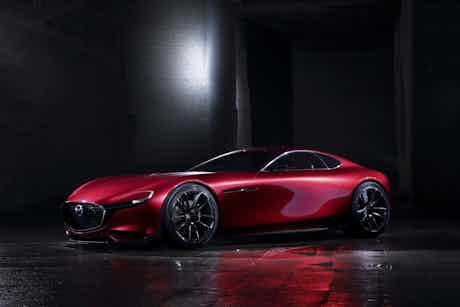Everything you need to know about the Mazda RX-9
March 17, 2020 by Nick Lette van Oostvoorne

Car changing is a big deal
Mazda is rumoured to be developing a successor to the legendary RX-7 and RX-8 sports cars – it’s called the Mazda RX-9. Here’s everything you need to know.
- Mazda sports car in development
- Likely to use a rotary engine
- Expected to be called the RX-9
- Inspired by 2015 RX Vision concept
- Still a few years away from going on sale
- Could cost from at least £50,000
Mazda design boss Ikuo Maeda has confirmed that a top-of-the-range sports car based on the RX-Vision Concept, and likely to be called the RX-9, is still a real possibility.
When could the Mazda RX-9 go on sale?
While it’s too soon to confirm a date for the launch of the new RX-9, what we do know is that it’s likely to carry over some of the technology that features in the MX-30 R-EV, in particular the rotary petrol engine.
The RX-9 will be Mazda’s flagship sports car and you can expect it to have a price tag of at least £50,000 to put it head-to-head with the Toyota Surpa and Porsche Cayman.

The Mazda RX-Vision’s design should inspire that of the new RX-9.
What to expect from the Mazda RX-9
There’s been talk of a new RX-9 – a successor to Mazda’s RX-7 and RX-8 sports cars – since the covers were whipped off the Mazda RX-Vision concept (pictured) way back in 2015.
It’s a testament to that car’s design that, four years on, it looks fresher than some brand-new cars. There are some obvious stylistic similarities to the new Mazda 3 including its kinked grille and piercing headlights and the two cars share the flowing lines of Mazda’s Kodo design philosophy.
The car’s poised stance could be thanks to the RX-9 coming with a compact new rotary engine that sits low down in the car. That seems to be confirmed by a design patent recently filed by Mazda which shows the front of a car which has space-consuming, double-wishbone suspension (the kind usually given to sports cars) and a small engine bay that would be the ideal home for a small-but-powerful rotary engine.

Instead of using conventional cylinders, the rotary engine’s rotor spins inside its housing to create a turning motion. It has fewer moving parts than conventional engines, is smaller, lighter and smoother. In the RX-9, you can expect it to be turbocharged to produce power of around 300hp, a figure that would get the car from 0-62mph in less than six seconds.
What that rotary engine should also mean is that the RX-9 will be great to drive, its low centre of gravity and lightweight making the car feel nimble in corners. Like the Mazda MX-5 sports car, you can expect the RX-9 to be rear-wheel drive and to send its power through a limited-slip differential that should make it easy to slide – on a race track, of course.
If you can’t wait for the RX-9 to go on sale read our in-depth Mazda MX-5 review for more information on its dinky soft-top sibling.